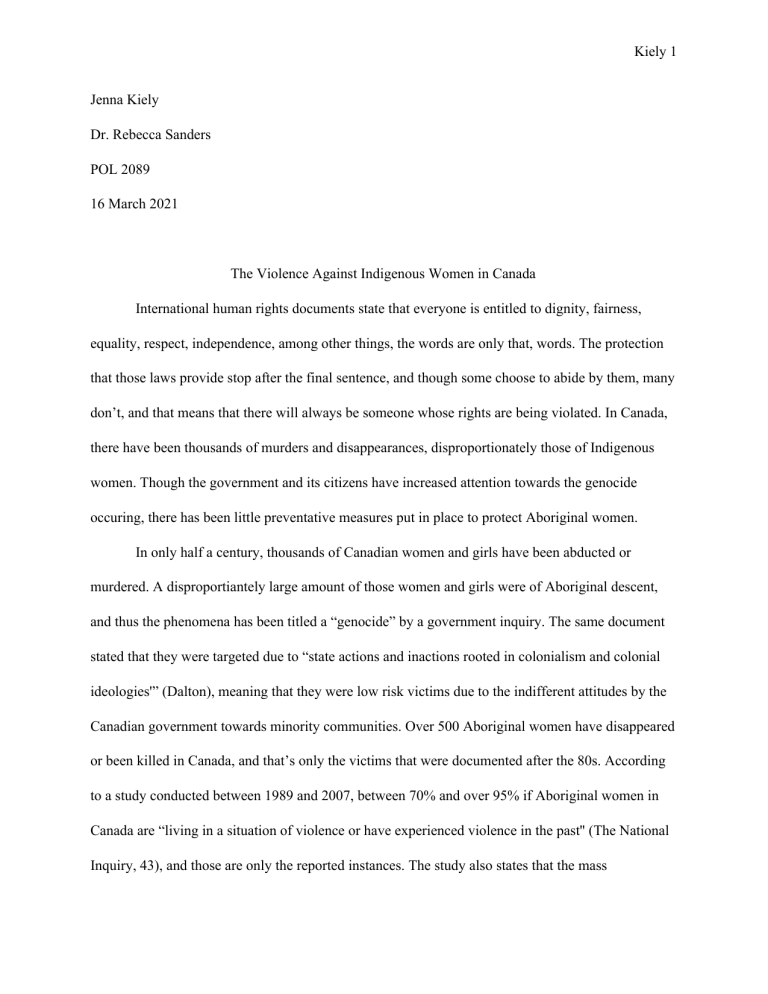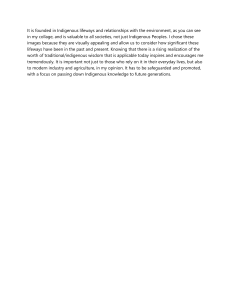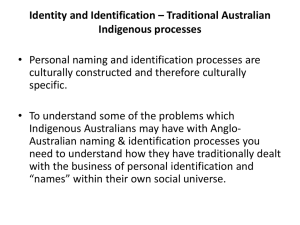
Kiely 1 Jenna Kiely Dr. Rebecca Sanders POL 2089 16 March 2021 The Violence Against Indigenous Women in Canada International human rights documents state that everyone is entitled to dignity, fairness, equality, respect, independence, among other things, the words are only that, words. The protection that those laws provide stop after the final sentence, and though some choose to abide by them, many don’t, and that means that there will always be someone whose rights are being violated. In Canada, there have been thousands of murders and disappearances, disproportionately those of Indigenous women. Though the government and its citizens have increased attention towards the genocide occuring, there has been little preventative measures put in place to protect Aboriginal women. In only half a century, thousands of Canadian women and girls have been abducted or murdered. A disproportiantely large amount of those women and girls were of Aboriginal descent, and thus the phenomena has been titled a “genocide” by a government inquiry. The same document stated that they were targeted due to “state actions and inactions rooted in colonialism and colonial ideologies'” (Dalton), meaning that they were low risk victims due to the indifferent attitudes by the Canadian government towards minority communities. Over 500 Aboriginal women have disappeared or been killed in Canada, and that’s only the victims that were documented after the 80s. According to a study conducted between 1989 and 2007, between 70% and over 95% if Aboriginal women in Canada are “living in a situation of violence or have experienced violence in the past'' (The National Inquiry, 43), and those are only the reported instances. The study also states that the mass Kiely 2 disappearances and murders are, again, due to a long history of both institutional and intimate violence against Indegenous women, citing once again that the main issue points towards colonialism and its byproducts. According to the International Bill of Rights, the targeted attacks made against Indigenous women are in violation of nearly all of the human rights outlined within it. The document states that all human beings are “born free and equal in dignity and rights” and states that they should all act in accordance to one another with a “spirit of brotherhood” and that all are entitled to the rights written in the doctrine without distinction from things such as race or sex, but the disproportionate attacks against Indigenous women do not coincide with said practice. It also says that everyone has the right to “security of person”, but the lack of protection and investigation into these disappearances from the Canadian government and the country as a whole doesn’t line up with said practice. It says that all are equal before the law and thus everyone is entitled to “equal protection of the law”, but, again, the lack of attention paid to the genocide does not correspond to said practice. On and on it goes as Aboriginal women are not included in the protections granted by the document. Though it’s main purpose is to stop violent crimes and other acts of discrimination, the document does little in a practical sense. When no in-house actions are being taken by the government against the perpetrators of this genocide, international human rights are flat out ignored. The systemic violence ignored by the government continues to make an appearance when Indigenous women are the accused party. A large portion of Aboriginal women have been charged with a crime, many even as minors, and a large percentage of those women also show signs of a history with abuse, both familial, relationship-wise, or other. Ellen Adelburg, an Indigenous women and author, wrote that “Aboriginal women who end up in prison grew up in prison, though the prisons they grew up in are not the ones to which they are sentenced under law” (McGillivray and Comaskey 94). Kiely 3 On the Canadian government’s website it says that it is “committed to ending the disappearances and deaths of Indigenous women ... and to helping prevent and eliminate violence against them in future generations” (“Backgrounder: Missing and Murdered”). As one of their main initiatives, the National Inquiry into Missing and Murdered Indigenous Women and Girls was launched in 2016 by the Canadian government. Between 2016 and 2019 the inquiry ran an analysis and collected data on the issue of the missing and murdered women, both with past and present information. The process included over 1,400 witnesses (both survivors and onlookers). During the research process, the Canadian government started to act, mostly in a preventative fashion. They began investing in housing, education, and other reforms for children and families so as to keep families together. The inquiry found many connections between violence against Aboriginal women and girls and the child welfare system and in response Canada has begun working NGOs to address the violence. They also signed a joint adventure with the Native Women’s Association of Canada Accord to develop policies, programs, and legislation to allow Aboriginal women and girls to share their voices. The fact that there must be legislation put in place to allow Indigenous women to share their perspective on the genocide being done upon their own communty is itself absurd, coupled with the fact that these negotiations with NWAC didn’t begin until 2019, three years after the inquiry began). The Candian government proposed 10 million dollars over the course of five years to be sufficient in revitalizing Indigenous protection laws. They have followed through on this proposition by releasing three pieces of legislation to protect victims of partner violence and human trafficking, reinforced sexual assault laws in the Criminal Code, and the Royal Canadian Mounted Police have resumed to investigate the cases of missing and murdered Indigenous women with more training so as to better handle the cases of the missing women. They have also hired full-time positions to aid in Kiely 4 the investigations (“Actions taken by the Government of Canada''). Though they deserve some recognition for their efforts, it is hard to argue that any of it was their idea in the first place. Their work with NGOs that have been pushing awareness and reform for decades proves that without the helping hands of the women being targeted, they would be none the wiser on the conditions these women face. Also, though the inquiry into the problem was important for its data collection so that the government could understand the scale and scope of the issue, the women and families are the ones that obviously provided the information for it to exist. While the Canadian government’s aid is helpful, it should have been there from the beginning. The investigations and government preventative programs are productives ways to prevent this from happening, but they do not bring back the hundreds of women already lost. The Canadian governments initiative into preventing more tragedy is a smart choice, and one I would recommend putting more funding into. Though the importance of finding the missing women and those that have hurt and abducted them is just as important, stopping the genocide from continuing should be the main priority as of right now. If the continued crimes against these women and children stops, there will be more people, funding, and other resources to help resolve past cases. Putting more into education of young Indigenous children, along with the relief of aiding Indigenous families find housing, healthcare, and other basic needs will be detrimental in the factors that often lead to domestic and familial abuse. And although the Canadian government has dedicated parts of their website towards the awareness of these issues, there must be more done to heighten media attention towards these cases. There have been numerous instances of the disappearance or killings of Aboriginal women being put on the backburner for national news programs so as to broadcast a similar crime done unto their white counterparts. The Canadian governments ignorance of the genocide for so long has subsequently led to a national blindness towards these missing women. Kiely 5 The main obstacle in these two reforms would be the attitudes of the nation. Due to the unawareness of the severity of the problem and the understatement by the government and other officials, why would people suddenly begin to take the issue seriously? Why would they want to put tax dollars towards a problem they can’t even begin to understand? The portion on the government’s webpage that describes the ways in which the government has dealt with the hundreds of cases of missing women is probably the most descriptive in terms of what is being done, but given that it is written in defense of the government’s actions, there is an obvious bias towards it. If I was none the wiser of the issue and that was provided as an all-encompassing article about the issue, I would assume that the government has it under control. The diction itself paints the government in a positive light and understates how severe the issue was and still is. This single website curated by the government encourages ignorance to continue. To begin to backtrack, the Canadian government must provide more comprehensive information so as to up the urgency and gain the public’s aid. The problem is bigger than the government, so it needs help on a much larger scale than the government itself can provide. In brief, the cases of missing and murdered Indigenous women is a problem that has and will continue to plague Canada for years to come. The disproportionate suffering that Aboriginal women have faced for generations must be stopped through preventative measures and also continued perseverance into the already opened investigations. Though the government has aided in recent years, the persistence of the Indigenous community, especially the female portion, is the reason work is being done today. Through their own efforts, many women have received the justice they deserved, and this strive for justice for each and every woman is what will eventually lead to the conclusion of these abductions and murders, though not without help from both national and global resources. Kiely 6 Works Cited Canada, Women and Gender Equality. “Backgrounder: Missing and Murdered Indigenous Women and Girls: Government of Canada Announces Support of Co...” Canada.ca, Government of Canada, 26 Nov. 2020, www.canada.ca/en/women-gender-equality/news/2020/07/backgroundermissing-and-murdered -indigenous-women-and-girls-government-of-canada-announces-support-of-commemoration-i nitiatives-in-nunavik.html. Gilchrist, Kristen. “‘Newsworthy’ Victims?” Feminist Media Studies, vol. 10, no. 4, 2010, pp. 373–390., doi:10.1080/14680777.2010.514110. Government of Canada; Crown-Indigenous Relations and Northern Affairs Canada. “Actions Taken by the Government of Canada since the Launch of the Inquiry.” Government of Canada; Crown-Indigenous Relations and Northern Affairs Canada, 3 June 2019, www.rcaanc-cirnac.gc.ca/eng/1559566331686/1559566355192#chp1. Grabham, Emily. Intersectionality and beyond: Law, Power and the Politics of Location. Routledge-Cavendish, 2009. McGillivray, Anne, and Brenda Comaskey. Black Eyes All of the Time: Intimate Violence, Aboriginal Women, and the Justice System. University of Toronto Press, 1999. “Murdered and Missing Women in Canada Is Genocide, Official Inquiry Finds.” The Independent, Independent Digital News and Media, 10 June 2019, www.independent.co.uk/news/world/americas/canada-genocide-murdered-missing-women-gir ls-indigenous-inquiry-report-a8939646.html. Reclaiming Power and Place: the Final Report of the National Inquiry into Missing and Murdered Kiely 7 Indigenous Women and Girls. National Inquiry into Missing and Murdered Indigenous Women and Girls, 2019. “Universal Declaration of Human Rights.” United Nations, United Nations, www.un.org/en/about-us/universal-declaration-of-human-rights.



